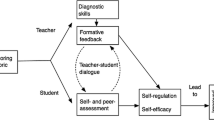Abstract
This paper is a commentary on the classroom interventions on the teaching and learning of proof reported in the seven empirical papers in this special issue. The seven papers show potential to enhance student learning in an area of mathematics that is not only notoriously difficult for students to learn and for teachers to teach, but also critically important to knowing and doing mathematics. Although the seven papers, and the intervention studies they report, vary in many ways—student population, content domain, goals and duration of the intervention, and theoretical perspectives, to name a few—they all provide valuable insight into ways in which classroom experiences might be designed to positively influence students’ learning to prove. In our commentary, we highlight the contributions and promise of the interventions in terms of whether and how they present capacity to change the classroom culture, the curriculum, or instruction. In doing so, we distinguish between works that aim to enhance students’ preparedness for, and competence in, proof and proving and works that explicitly foster appreciation for the need and importance of proof and proving. Finally, we also discuss briefly the interventions along three dimensions: how amenable to scaling up, how practicable for curricular integration, and how capable of producing long-lasting effects these interventions are.

Similar content being viewed by others
References
Balacheff, N., & Margolinas, C. (2005). cK¢ modèle de connaissances pour le calcul de situations didactiques. In A. Mercier & C. Margolinas (Eds.), Balises pour la didactique des mathématiques (pp. 75–106). Grenoble, France: La Pensée Sauvage.
Bieda, K. (2010). Enacting proof-related tasks in middle school mathematics: Challenges and opportunities. Journal for Research in Mathematics Education, 41, 351–382.
Boero, P., Garuti, R., Lemut, E., & Mariotti, M. A. (1996). Challenging the traditional school approach to theorems: A hypothesis about the cognitive unity of theorems. In L. Puig & A. Gutiérrez (Eds.), Proceedings of the 20th PME conference (pp. 113–120). Valencia, Spain: PME.
Brousseau, G. (1997). Theory of didactical situations in mathematics. Dordrecht: Kluwer.
Council of Chief State School Officers. (2010). Common Core state standards for mathematics. Washington, DC: Council of Chief State School Officers.
Department for Education. (2014). Mathematics programmes of study: key stages 1 and 2: National curriculum in England. Retrieved from https://www.gov.uk/government/publications/national-curriculum-in-england-mathematics-programmes-of-study. Accessed 9 July 2007.
Fukawa-Connelly, T., Johnson, E., & Keller, R. (2016). Can math education research improve the teaching of abstract algebra? Notices of the American Mathematics Society, 63, 276–281.
Habermas, J. (1998). On the pragmatics of communication. Cambridge, MA: MIT Press.
Harel, G., & Sowder, L. (2007). Toward comprehensive perspectives on the learning and teaching of proof. In F. Lester (Ed.), Second handbook of research on mathematics teaching and learning (pp. 805–842). Charlotte: Information Age Publishing.
Kanellos, I., Nardi, E., & Biza, I. (2013). The interplay between fluency and appreciation in secondary students’ first encounter with proof. In A. M. Lindmeier & A. Heinze (Eds.), Proceedings of the 37th Conference of the International Group for the Psychology of Mathematics Education (PME) (p. 84). Kiel, Germany: PME.
Knuth, E. (2002a). Secondary school mathematics teachers’ conceptions of proof. Journal for Research in Mathematics Education, 33(5), 379–405.
Knuth, E. (2002b). Teachers’ conceptions of proof in the context of secondary school mathematics. Journal of Mathematics Teacher Education, 5(1), 61–88.
Knuth, E., Zaslavsky, O., & Ellis, A. (2017). The role and use of examples in proving-related activities. Journal of Mathematical Behavior, (in press).
Nardi, E. (2008). Amongst mathematicians: Teaching and learning mathematics at university level. New York: Springer.
Ozgur, Z., Vinsonhaler, R., Dogan, M., Knuth, E., & Ellis, A. (2017). From examples to proof: Purposes, strategies, and affordances of example use. Journal of Mathematical Behavior, (in press).
Pedemonte, B. (2005). Quelques outils pour l’analyse cognitive du rapport entre argumentation et démonstration. Recherches en Didactique des Mathématiques, 25(3), 313–348.
Perelman, C., & Olbrechts-Tyteca, L. (1969). The new rhetoric: A treatise on argumentation (J. Wilkinson & P. Weaver, Trans.). Notre Dame: University of Notre Dame.
Sowder, L., & Harel, G. (1998). Types of students’ justifications. Mathematics Teacher, 91, 670–675.
Stylianides, G. J., & Stylianides, A. J. (2009). Facilitating the transition from empirical arguments to proof. Journal for Research in Mathematics Education, 40, 314–352.
Stylianides, A. J., & Stylianides, G. J. (2013). Seeking research-grounded solutions to problems of practice: Classroom-based interventions in mathematics education. ZDM, 45, 333–341.
Stylianides, G. J., Stylianides, A. J., & Shilling-Traina, L. N. (2013). Prospective teachers’ challenges in teaching reasoning-and-proving. International Journal of Science and Mathematics Education, 11, 1463–1490.
Stylianides, A. J., Bieda, K. N., & Morselli, F. (2016). Proof and argumentation in mathematics education research. In A. Gutiérrez, G. C. Leder, & P. Boero (Eds.), The second handbook of research on the psychology of mathematics education (pp. 315–351). Rotterdam: Sense Publishers.
Stylianides, G. J., Stylianides, A. J., & Weber, K. (2017). Research on the teaching and learning of proof: Taking stock and moving forward. In J. Cai (Ed.), Compendium for research in mathematics education (pp. 237–266). Reston: National Council of Teachers of Mathematics.
Toulmin, S. E. (2003). The uses of argument (updated ed). Cambridge: Cambridge University Press. (Original work published 1958)
Zaslavsky, O., Nickerson, S., Stylianides, A., Kidron, I., & Winicki, G. (2012). The need for proof and proving: Mathematical and pedagogical perspectives. In G. Hanna & M. de Villiers (Eds.), Proof and proving in mathematics education (pp. 215–229). New York: Springer.
Author information
Authors and Affiliations
Corresponding author
Rights and permissions
About this article
Cite this article
Nardi, E., Knuth, E. Changing classroom culture, curricula, and instruction for proof and proving: how amenable to scaling up, practicable for curricular integration, and capable of producing long-lasting effects are current interventions?. Educ Stud Math 96, 267–274 (2017). https://doi.org/10.1007/s10649-017-9785-0
Published:
Issue Date:
DOI: https://doi.org/10.1007/s10649-017-9785-0




